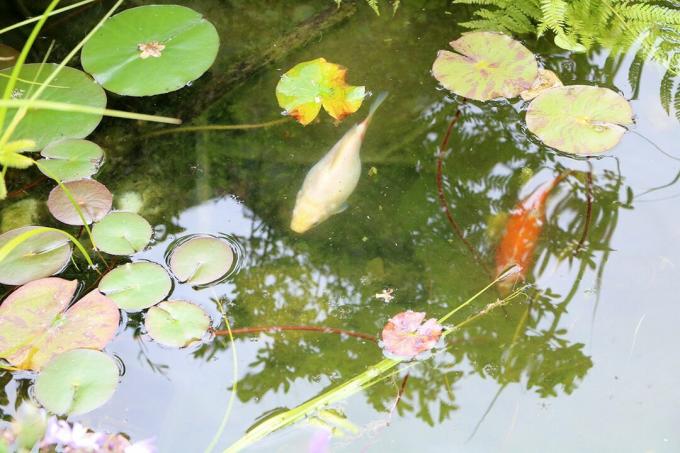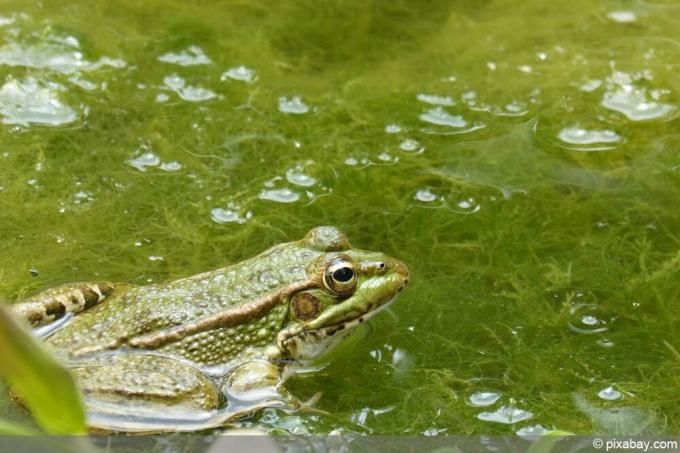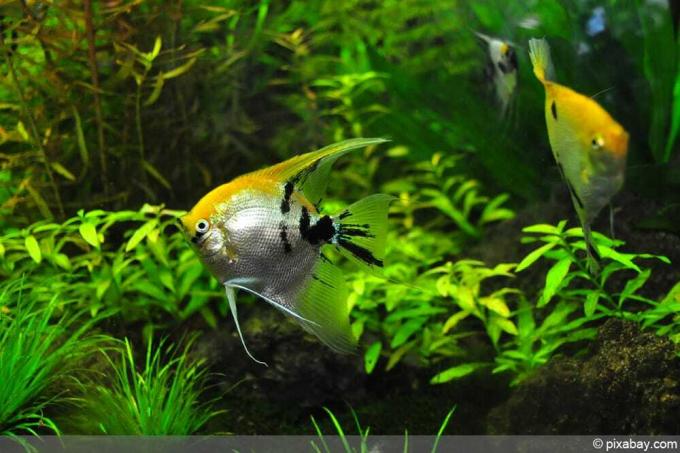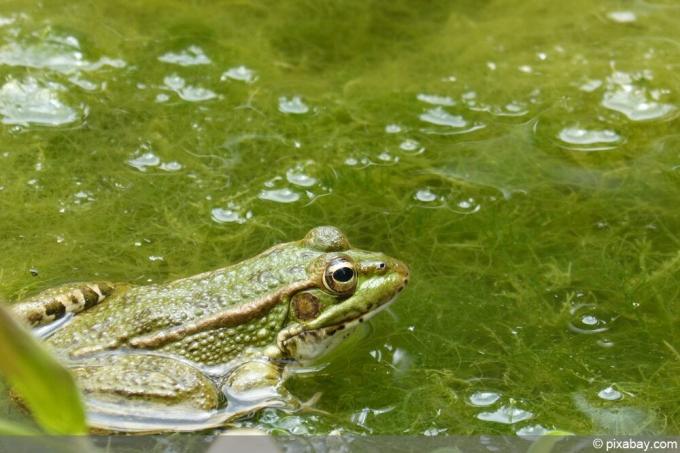

Table of contents
- Cause of algae development
- Why remove algae?
- skim off
- UV-C clarifier
- Skimmers and pond silt suckers
- algaecides
- phosphate binder
- renovation
- predators
- small ponds
- Big ponds
- Reduce nutrients with aquatic plants
- Fast-growing pond plants
- riparian zone
- water surface
- preventive measures
- pond shape
- lighting conditions
- PH value
There are different methods to combat floating algae, but not all of them are equally recommended. We will tell you which measures are most effective and at the same time safe for aquatic animals and plants.
Cause of algae development
Floating algae are usually blue or green plants that are microscopic and float on the water surface. The water itself remains clear, while the surface is covered in a greenish shimmering veil. Floating algae usually appear in spring, since the nutrient supply in the pond is particularly high at this time. But not only the time of year is a possible cause for the development of algae:
Increased phosphorus content
A phosphorus content of around 0.0035 milligrams per liter can already lead to an algal bloom. Among other things, it rises when excess fish food and fish droppings sink to the bottom. Likewise, when it rains, nutrient-rich soil can be washed into the pond, which increases the phosphorus content.
water temperature and solar radiation
The increased solar radiation in spring and summer and the resulting increase in water temperature also have a positive effect on the development of algae.
dead algae
As soon as the algae die, they sink to the bottom and form the basis for the next algae bloom in the pond. As a result, the cycle repeats itself and the algae problems become more intense from year to year.
Too high pH
The ideal pH value of a pond is between 6.8 and 8.2. If this is too high, this favors an algae infestation.
Why remove algae?
Algae are not bad per se, because they remove nutrients from the pond, but at the same time provide oxygen. The problem here is that they remove as much oxygen from the water throughout the day as they produce. This results in strong oxygen fluctuations between day and night.
It should not be forgotten that the lack of oxygen poses a threat to other aquatic plants and fish. Floating algae also ensure an increased pH value and a lower KH value (carbon hardness). These factors are also not favorable for fish and co. For this reason it is advisable to remove the floating algae. It is practical that there are different methods available for this:
skim off
Skimming off algae can be particularly helpful in ponds that are still in the acclimatization phase, as plants and aquatic animals have not yet created a balance. It is therefore advisable to remove the algae right from the start by skimming them off. At the same time, it is also a good idea to remove leaves, pollen and other organic materials.
UV-C clarifier
A UV-C clarifier is a UV-C lamp that destroys the structure of the algae. In many cases, such a light medium is already integrated into the filter system, but it is also possible to buy it separately. It is important that the UV-C clarifier is installed in front of the filter so that the dead floating algae can be caught by the filter. Because a UV-C clarifier works as follows: The water is passed through the luminous medium, where the genetic information of the algae is destroyed by ultraviolet light. The algae clump together and are subsequently transported away in the filter.
- Advantage: harmless for pond and residents, easy handling
- Disadvantage: lasts only one season, then has to be renewed
Skimmers and pond silt suckers
Both a skimmer and a pond sludge vacuum are generally highly recommended devices and have also proven useful in combating floating algae. The skimmer picks up pollen and algae so that they do not get to the bottom of the pond. Instead, they are transported away in the filter or picked up in the filter basket. The handling varies depending on the model, because there are free-floating or standing skimmer as well as those that are connected directly to the filter pump. A pond sludge vacuum, on the other hand, removes deposits from the bottom.

algaecides
Algicides are algae killers that work differently depending on the preparation. In most cases, however, algaecides are used, which cause the floating algae to clump together so that they can be easily absorbed by the filter. Although algicides such as monolinuron or copper sulfate are very effective, they should also be used with caution. Because they not only destroy floating algae, but are also harmful to fish and microorganisms if the wrong dosage is used.
- Use only with exact knowledge of the pond volume
- Correct dosage is crucial!
- Too much: harmful for pond inhabitants
- Too little: ineffective
phosphate binder
Phosphate is the basic nutrient of algae, which is why many pond owners use a phosphate binder when floating algae appear. The mineral binding agent binds the phosphate so that the nutrient is no longer accessible to the algae and they eventually starve. In contrast to algaecides, phosphate binders are harmless to fish and are not absorbed by other aquatic plants. There are different versions of phosphate binders:
- Can be used in filters
- Powder: sprinkle into the water
- Liquid form: put into water
Info:
The pH value of the pond water is lowered by using a phosphate binder.
renovation
With a renovation Floating algae can also be destroyed by general cleaning of the pond. It is important that not only the pond water is changed. Because the substrate and the plants also have an effect on the nutrient content of the water and can promote algae infestation. It is therefore advisable to carry out the following maintenance measures:
- change water
- Remove a layer of sludge from the pond bottom
- Replace old pond soil with new, nutrient-poor substrate
- e.g. B.: nutrient-poor sand
- Prune and divide plants vigorously
- Then put in new substrate
- Clean all utensils
predators
Predators have also proven useful in fighting algae because they "work" like a biological filter. Ideally, the animals feed primarily on natural food sources such as algae. Because an additional supply of fish food would increase the nutrient content of the pond and thus have a positive effect on the development of algae. Depending on the size of the pond, the following scavengers are available to combat algae:
small ponds
- rudd
- goldfish
- water fleas
- European freshwater shrimp
- pond mussels
- snails
Big ponds
- grass carp
- silver carp
- Koi Carp
A notice:
Be careful when using larger fish such as carp, because they not only destroy algae, but also eat smaller fish and soft pond and underwater plants.
Reduce nutrients with aquatic plants

The more plants there are in the pond system, the faster nutrients can be bound and the less food is left for algae. It is therefore advisable to always plant aquatic plants that are happy about phosphate and nitrate. Different plants are suitable for this purpose:
Fast-growing pond plants
- horn leaf
- waterweed
- thousand leaf
- water screw
riparian zone
- water bulrush
- loosestrife
- Small cattail
- iris
water surface
- fresh bite
- crab claws
- duckweed
A notice:
Plants should be pruned regularly to remove nutrients from the nutrient cycle. The clippings can then be disposed of in the compost.
preventive measures
Although algae can be destroyed very easily, it is of course always desirable if they do not appear in the first place. Although they cannot be completely avoided, there are effective precautionary measures that can be used to significantly reduce the risk of algae infestation.
pond shape
Many pond owners opt for a pond with a sink because it looks the most natural. Unfortunately, such a shape also encourages mineral fertilizers and garden soil to be washed into the pond. This in turn can affect the phosphate content and promote algae development. For this reason, it is advisable to consider the following when considering the shape of the pond:
- Choose the best place with a slight elevation
- Pond surrounded by a drainage ditch, approx. 60 cm deep
- Fill the trench with coarse sand
- Ensure water movement! (fountains or watercourses)
Already knew?
Algae are more common in small and shallow bodies of water.
lighting conditions
High temperatures and a lot of sunlight favor the development of algae, which is why a pond should be at least one third in the shade. A large awning, for example, is suitable as a source of shade, but a high density of pond plants also offers protection from the sun's rays.

There are also numerous plants with large floating leaves that not only float decoratively on the water surface, but also offer protection from the sun's rays:
- frog bite
- lotus
- sea can
- water lily
PH value
The ideal pH value of the water is between 6.8 and 8.2, with this usually being lower in the morning than in the evening. Normally, the pH value increases during the day due to external influences, which in turn is a good sign that the pond environment is functioning. However, too high a pH value has a positive effect on the development of algae, which is why it should be checked regularly. If the pH value is too high, it can be lowered with simple measures:
- Put the jute bag with peat into the water
- Connect firmly and attach to the edge of the pond
- Replace peat after 3 to 4 weeks if necessary
Alternatively, an oak branch can also be placed on the ground, because the oak bark contains tannic acids that lower the pH value. It is important that the branch is removed before it decomposes.
 garden editorial
garden editorial I write about everything that interests me in my garden.
Learn more about algae in the pond

Algae eater in the pond: 5 hungry pond fish
Algae growth in the garden pond not only looks unsightly, but excessive growth can tip the entire ecosystem over. In this article we will tell you which types of fish, snails and mussels like to eat algae and what else helps against the "green plague".

Combat thread algae in the aquarium
The right countermeasures must be taken at an early stage to ensure that the thread algae in the aquarium do not grow too rampant and become a nuisance. Otherwise, the aquatic plants can severely disturb the sensitive ecosystem of the aquarium and also negatively affect the visual appearance.

Get rid of green algae in the aquarium properly
Green algae occur in every aquarium. This is normal and part of it. It can even speak for a particularly good water quality. Only a massive increase in algae caused by too much light and too many nutrients is not normal. The green coloring and turbidity of the water means nothing other than that the biological balance has gotten out of joint. There are different green algae, also with quite different requirements. However, all benefit from an excess of food and can best be combated by depriving them of food.

Natural remedies against thread algae
Algae in the garden pond are an absolute nuisance, but can hardly be avoided. Besides, they are useful too. They serve as food for microorganisms and also produce vital oxygen. It gets annoying when they multiply en masse.

The best home remedies for algae in the aquarium
Algae in the aquarium are absolutely natural and normally do not have to be fought. It only becomes difficult when they multiply explosively. There is a reason for this increase. It has to be found and turned off. That sounds simple, but it isn't.

Combat diatoms in the aquarium - in 5 steps
Diatoms occur mainly in newly set up freshwater and seawater aquariums, but can also appear during normal aquarium operation. This is mainly due to the initially high concentration of silicates.
